هل تشعر أنك وجدت حلاً لإحدى أكثر مشاكل شركتك إلحاحًا؟ هل تريد أن تذهب مباشرةً إلى رؤسائك وتخبرهم بفكرتك مستمتعًا بمجد لحظة اكتشافك للحل؟ 💡
قبل أن تفعل ذلك، خذ نفساً عميقاً وفكر فيما إذا كان الحل الذي توصلت إليه يتطلب التزاماً مالياً كبيراً أو تحولاً إلى وظائف الأعمال الحرجة . إذا كان الأمر كذلك، يجب عليك تعلم كيفية كتابة دراسة الجدوى لتقديم فكرتك بشكل صحيح إلى المسؤولين الكبار.
ألم تفعل ذلك من قبل؟ لا تقلق. في هذه المقالة، سوف نستكشف:
- مفهومحالة العمل
- الفرق بين دراسة الجدوى وخطة العمل
- عملية بناء حالة عمل مقنعة
- بعضأمثلة واقعية لفهم كيف تساعد حالات العمل في الحصول على الموافقة على المشروع
ما هي حالة العمل؟
تشرح دراسة الجدوى كيف أن عوائد الاستثمار في فكرة أو مبادرة تجارية تفوق المخاطر والتكاليف.
إنها واحدة من العديد من وثائق إدارة المشروع (مثل دراسة الجدوى) ميثاق المشروع أو خطة المشروع ) التي قد تضطر إلى إنشائها عند السعي للحصول على الضوء الأخضر للمضي قدماً في المشروع. يمكن أن تكون حالة العمل المصممة بشكل جيد حاسمة للحصول على موافقة العميل أو الإدارة أو أصحاب المصلحة الآخرين في المراحل الأولى من دورة حياة المشروع . 🟢
أهمية دراسة حالة العمل في إدارة المشروع
الدور الرئيسي لحالة العمل هو تبرير الاستثمار. وتلعب أدوارًا أخرى مهمة تجعل إدارة المشروع بشكل أكثر كفاءة . وتشمل بعضًا منها:
- توفير الوضوح: تتطلب صياغة دراسة الجدوى تخطيطًا وبحثًا دقيقًا، مما يضفي وضوحًا في التفكير ويحسن من فهمك للمبادرة أو المشروع الذي ستقترحه
- تحسين الموارد: تساعد دراسة الجدوى على ضمان استخدام موارد الشركة بشكل مثمر والمساهمة في تحقيق أهدافها الاستراتيجية طويلة الأجل
- إزالة الشكوك: من خلال مقارنة الحلول المختلفة، تزيل الوثيقة أي شك في أن هناك طريقة بديلة لحل مشكلة العمل أفضل من الطريقة التي تقترحها
يمكن أن يستغرق إعداد دراسة الجدوى الكثير من الوقت والجهد، لذلك من المنطقي فقط عندما يتطلب المشروع أو المبادرة التزاماً مالياً كبيراً. بالنسبة لجميع الموافقات الأخرى، يمكنك استخدام ميثاق المشروع. تتضمن بعض السيناريوهات التي يمكن أن تكون فيها حالة العمل منطقية ما يلي:
- مشروع جديد
- خط إنتاج جديد
- تقديم منتج جديدشخصية العميل إلىاستراتيجية التسويق
- التغييرات الرئيسية في سلسلة التوريد، مثل إدخال موردين أو موزعين جدد
ما الفرق بين دراسة الجدوى وخطة العمل؟
بينما قد تبدو دراسة الجدوى مرادفًا لخطة العمل خطة العمل بناءً على تعريفها ومحتواها واسمها، هناك اختلافات كبيرة بينهما. أبرزها:
- حالة الاستخدام: يتم وضع خطة عمل لمشروع جديد بالكامل، بينما يتم إنشاء حالة عمل عند طلب التزام مالي كبير ضمن مشروع قائم
- الغرض: تهدف خطة العمل إلى وضع استراتيجية عمل كاملة، بينما تحاول دراسة الجدوى شرح مزايا مبادرة محددة
- المحتوى: تتضمن خطة العمل معلومات حول:
- A
رسالة الشركة ورؤيتها
- التوقعات المالية
- تحليل SWOT
- تحليل السوق
- استراتيجية التوجه إلى السوق
- الملف الشخصي للفريق
- A
رسالة الشركة ورؤيتها
من ناحية أخرى، تتضمن دراسة الجدوى فقط التوقعات المالية والمخاطر وتكاليف المشروع
- مستوى التفاصيل: نظراً لنطاق المعلومات التي تحتاج إلى تغطيتها، تميل خطط العمل إلى أن تكون أكثر تفصيلاً من حالات العمل
العناصر الرئيسية لحالة العمل
في حين أن الهيكل الدقيق لحالة العمل سيختلف بناءً على حالة معينة، إليك بعض المكونات الأساسية:
1. الملخص التنفيذي
يقدم الملخص التنفيذي نظرة عامة سريعة للتفاصيل المهمة التي تغطيها دراسة الجدوى الخاصة بك.
ونظرًا لأن المديرين والمديرين التنفيذيين عادةً ما يكون لديهم ضيق في الوقت، فإن الملخص التنفيذي غالبًا ما يكون الجزء الوحيد من المستند الذي يقرؤونه بالفعل. لذلك من المهم جدًا أن يكون هذا الجزء من المستند صحيحًا وأن يترك انطباعًا أوليًا قويًا.
2. تعريف المشروع
تعريف المشروع يحدد السياق لحالة عملك من خلال شرح المشكلة التي تهدف إلى حلها. فهو يسلط الضوء على متطلبات العمل التي لم يتم الوفاء بها، ويوضح سبب عدم تلبيتها، وأخيرًا يعرض الحل الذي ستقدمه لمعالجة أوجه القصور المذكورة.
3. التقييم المالي
هذا هو جوهر المسألة - الجزء الخاص بالتقييم المالي يحدد عائد الاستثمار الذي من المحتمل أن تحققه مبادرتك أو مشروعك المقترح للأعمال. كما أنه يغطي التكلفة المتوقعة لـ تنفيذ مشروعك أو تنفيذ الحل الخاص بك.
4. أهداف المشروع ومعايير النجاح
يحدد هذا الجزء من دراسة الجدوى كل ما يلي الأهداف والنتائج الرئيسية (OKRs) التي تريد تحقيقها من خلال المشروع أو الحل المقترح. ويوضح أيضًا كيف تتوافق هذه الأهداف مع أهداف الشركة قصيرة الأجل وطويلة الأجل. وأخيرًا، تحدد معايير النجاح لمشروعك في شكل مؤشرات الأداء الرئيسية والمقاييس الرئيسية .
5. نطاق المشروع والجدول الزمني
يضع نطاق المشروع حدودًا وحدودًا لمشروعك من خلال تخصيص الموارد والميزانيات ووضع جدول زمني للإنجاز.
6. المخاطر واستراتيجيات التخفيف من حدتها
يجب أن تسرد دراسة الجدوى جميع المخاطر المرتبطة بتنفيذ الحل المقترح واستراتيجيات التخفيف من حدتها للتعامل معها. كما أنها تتناول النهج البديلة والمخاطر الخاصة بكل منها لشرح السبب الذي يجعل مبادرتك هي الخيار المفضل.
كيفية كتابة دراسة الجدوى في 8 خطوات
تعد كتابة دراسة الجدوى مهمة معقدة تتطلب بحثًا مكثفًا وتحليلات عديدة، بدءًا من تحليل SWOT وتحليل التكلفة والعائد إلى تحليل أصحاب المصلحة. إنها ليست نزهة في الحديقة، ولكنها تصبح أسهل بكثير مع منصة استثنائية لإدارة المشاريع مثل انقر فوق .
يزوّد ClickUp مديري المشاريع والمتخصصين في مجال الأعمال بجميع الأدوات التي يحتاجونها لصياغة دراسة جدوى من شأنها أن تكسب قلوب وعقول رؤسائهم - بدءًا من القوالب الجاهزة إلى ميزات إدارة المستندات المدعومة بالذكاء الاصطناعي. دعنا نتعرف على كيفية كتابة حالة عمل في ثماني خطوات بمساعدة ClickUp.
الخطوة 1: تحديد المشكلة
تفشل العديد من المشاريع التجارية لأنها تخلق حلولاً لمشاكل غير موجودة. لتجنب هذا السيناريو، تأكد من مراعاة ما يلي:
- الهدف (الأهداف) التي تريد شركتك تحقيقها. ومن الأمثلة على ذلك تحقيقالإيرادات المستهدفةأو تلبية حاجة عميل لم تتم تلبيتها أو تحقيق ميزة تنافسية
- مشكلة (مشاكل) تمنع شركتك من تحقيق أهدافها المنشودة. ومن الأمثلة على ذلك نقصالكفاءة التشغيليةوالاستهداف غير الصحيح للعملاء، ومشكلات سلسلة التوريد
- الحل الذي تريد اقتراحه لحل المشكلة وتحقيق الأهداف
- الأدلة ودراسات الحالة لإثبات أن الحل المقترح الخاص بك يمكن أن يحل المشكلة بالفعل
هناك طريقة منظمة لتحديد مشاكل عملك وهي استخدام نموذج تحليل الأسباب الجذرية ل ClickUp . صنف كل شيء يسير بشكل خاطئ في عملك إلى عدة أعمدة "لماذا" ثم أضف أسبابها الجذرية في الكتل المرمزة بالألوان ذات الصلة. بمجرد أن تقوم بتحليل الأسباب الجذرية، يمكنك تخصيص الحل الخاص بك لاستهدافها وإصلاحها.
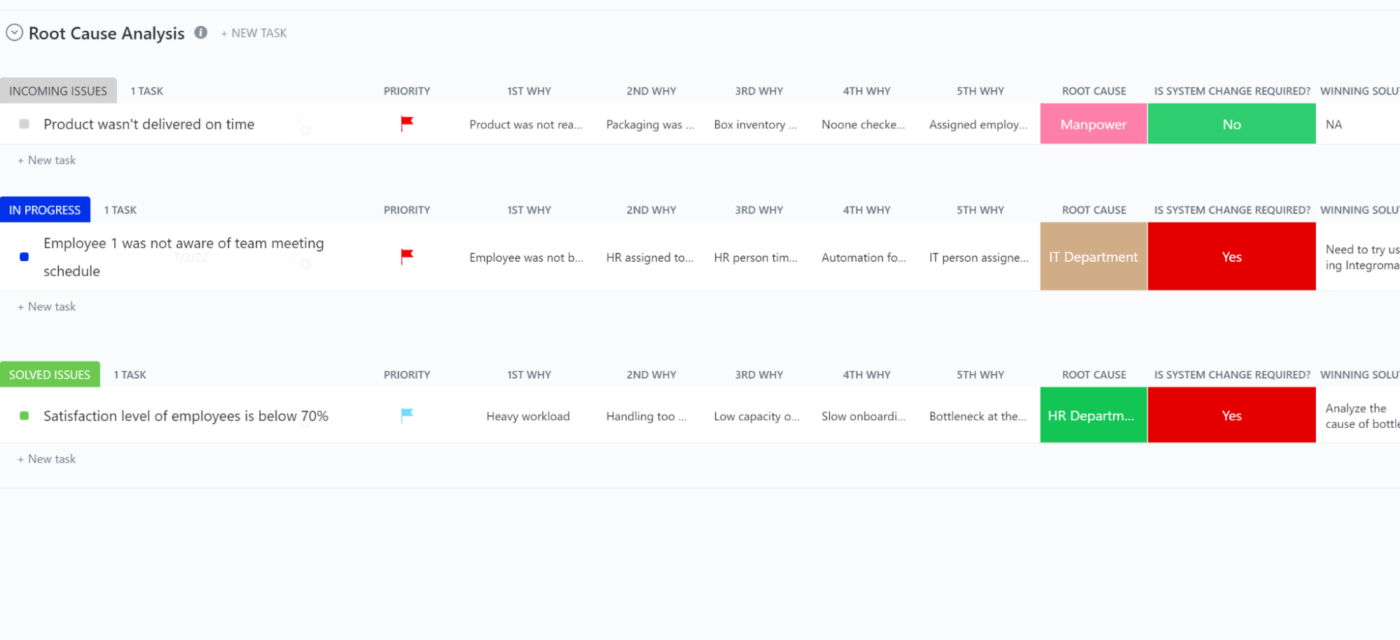
استخدم قالب تحليل الأسباب الجذرية في ClickUp لتحديد مشاكل العمل وأسبابها، ووضع خطط للإجراءات التصحيحية
/ctaBtn/الأخضر https://app.clickup.com/signup?template=t-216177975 تنزيل هذا النموذج /%ctaBtnTn/
الخطوة 2: تحديد أصحاب المصلحة
بعد تحديد المشكلة بدقة، فإن الخطوة التالية هي تحديد أصحاب المصلحة الذين ستعرض عليهم حالة عملك. صاحب المصلحة هو أي شخص له رأي في الموافقة على حالة عملك. واعتماداً على نطاق وتعقيد حالة العمل الخاصة بك، قد يلعب أحد أو جميع أصحاب المصلحة التاليين دوراً في الموافقة عليها:
- صاحب المصلحةالرئيس التنفيذي (الرئيس التنفيذي) للشركة
- رئيس قسم الشؤون المالية
- رئيس قسم العمليات التجارية
- رئيس قسم التسويق والمبيعات
- ممثل العميل
ناقش مبادرتك مع أصحاب المصلحة لمعرفة ما إذا كانوا مهتمين بها أم لا. يمكن أن يساعدك أيضًا على فهم وجهة نظرهم حول المشكلة التي تهدف إلى حلها. ففي نهاية المطاف، أنت لا تريد أن تبذل جهودك في دراسة حالة عمل كاملة فقط لكي يرفضها أصحاب المصلحة. 🙅♂️
إن أسهل طريقة لتحديد أصحاب المصلحة الرئيسيين هي الاستفادة من قالب تحليل أصحاب المصلحة في ClickUp . يمكن أن يساعدك هذا الإطار في قياس مستوى تأثير ودعم جميع أصحاب المصلحة الذين سيلعبون دورًا في الموافقة على حالة عملك. يمكن أن تكون هذه المعلومات مفيدة أيضًا عندما ترغب في جمع الملاحظات من أحد أصحاب المصلحة.
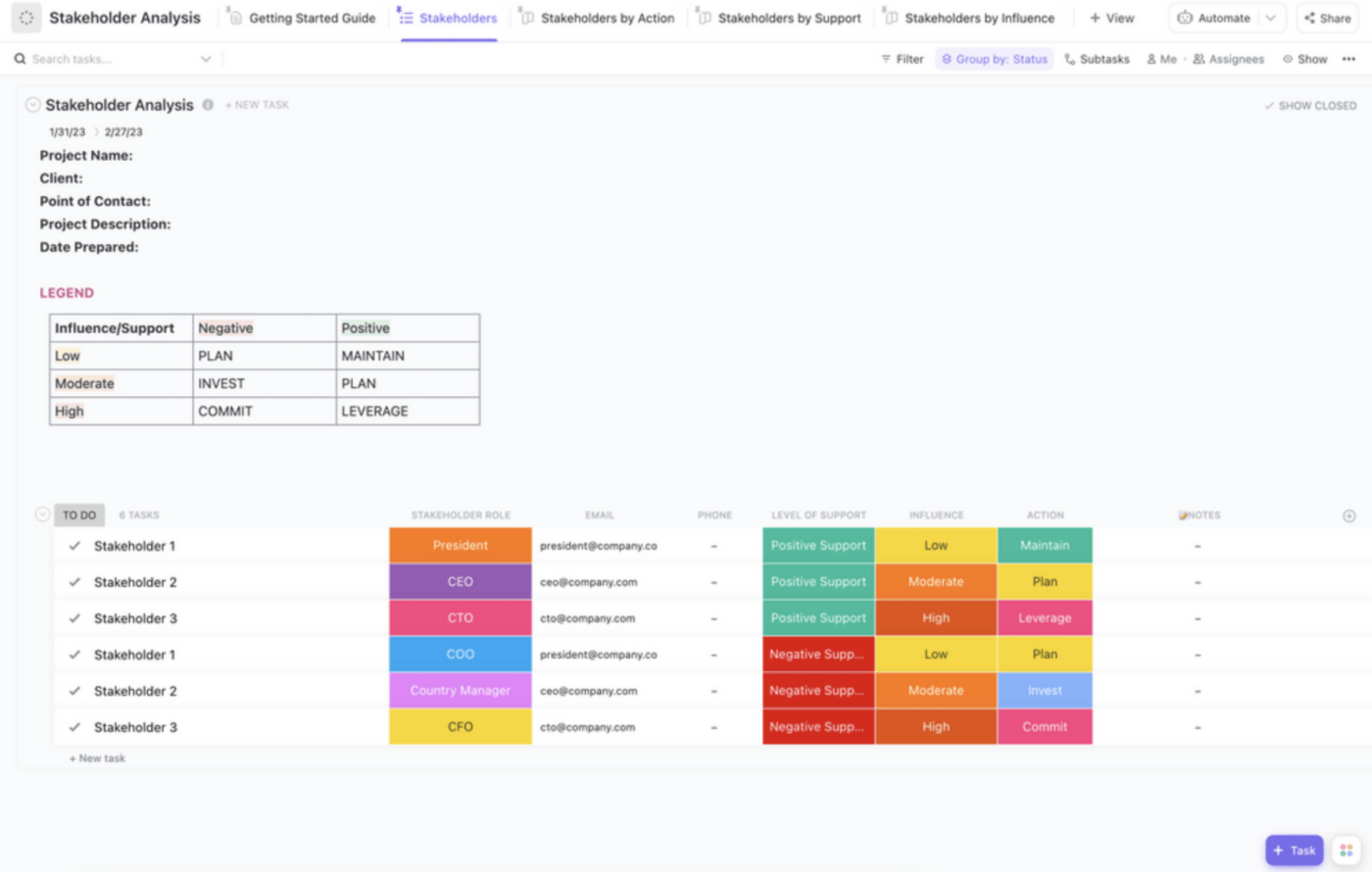
حدد اللاعبين الرئيسيين في المشروع ومستوى دعمهم باستخدام قالب تحليل أصحاب المصلحة ClickUp Stakeholder Analysis Template
/ctaBtn/الأخضر https://app.clickup.com/signup?template=t-222088013 تنزيل هذا القالب /%ctaBtntn/
الخطوة 3: صياغة المعلومات الأساسية وتعريف المشروع
بمجرد تحديد مشكلتك وأصحاب المصلحة المعنيين، فقد حان الوقت للبدء في صياغة حالة العمل الخاصة بك.
الجزء الأول هو قسم تعريف المشروع، والذي يحدد خلفية عرض قضيتك أمام أصحاب المصلحة. وهو يغطي المشكلة التي تواجهك حالة العمل التي تقترحها لحلها ويشرح سبب أهمية حل المشكلة. يجب أن يغطي القسم ما يلي:
- المشكلة التي حددتها وتأثيرها على وظائف العمل
- كيف يمكن لمشروعك أو الحل أن يحلها
- الأهداف التي يريد مشروعك أو مبادرتك تحقيقها
- كيفأهداف المشروع تتماشى مع أهداف الشركة على المدى القريب
- معايير نجاح مشروعك أو مبادرتك
- كيف سينقل نجاحه الشركة نحو أهدافها الاستراتيجية طويلة الأجل
أفضل أداة لصياغة هذا الجزء من الوثيقة هي مستندات ClickUp -محرر النصوص المدمج في ClickUp ومنصة إدارة الوثائق.
وبفضل إمكانيات التحرير التعاوني التي توفرها ClickUp Docs، يمكنك أنت وأصحاب المصلحة العمل على مستند حالة العمل في الوقت الفعلي، مما يضمن سرعة ودقة إنجازه. يمكن لأصحاب المصلحة أيضًا التعليق على مجالات التحسين . أخيرًا، يمكنك إضافة صورة غلاف لجعل حالة عملك تبدو أكثر جاذبية أو استخدام أوامر الشرطة المائلة لإضافة كتل مقنعة من النص المنسق بسرعة.

استخدم مستندات ClickUp Docs للتنسيق الغني وأوامر الشرطة المائلة للعمل بكفاءة أكبر
الخطوة 4: تحليل التكلفة والعائد والتقييم المالي
بعد إعداد الخلفية، الخطوة التالية هي الجزء الخاص بالتقييم المالي. سيتم فحص هذا القسم بعناية خلال عرضك التقديمي وسيعمل على جذب اهتمام أصحاب المصلحة في حالة عملك. لتحقيق أقصى قدر من الدقة، استشر زميلاً من قسم الشؤون المالية أثناء صياغة هذا الجزء من المستند.
تتضمن بعض المعلومات التي قد ترغب في تغطيتها هنا ما يلي:
- التوقعات حول المكاسب المالية
- التكاليف التي سيتكبدها المشروع
- توقعات التدفق النقدي
- تحليل التكلفة والعائد والعائد على الاستثمار (ROI)
- تحليل الحساسية لتوضيح هامش الخطأ في أرقامك
إلى جانب الجوانب المالية، يتناول هذا القسم أيضًا ما يلي تحليل المخاطر . معلومات حول جميع عوامل المخاطر المحتملة التي تم تحديدها من خلال تحليل SWOT وتحليل مونت كارلو وغيرها من استراتيجيات تحديد المخاطر إلى جانب استراتيجيات تحديد المخاطر استراتيجيات التخفيف . سيكون من الأفضل مناقشة مخاطر المشروع مع أصحاب المصلحة الذين تم تحديدهم في الخطوة الأولى - فغالبًا ما يمكنهم مشاركة الرؤى ووجهات النظر الخفية.
يوفر ClickUp عددًا من الأدوات لمساعدتك في إجراء كل من هذه التحليلات. على سبيل المثال، يمكنك استخدام قالب تحليل تكلفة وفوائد ClickUp لإكمال تحليل التكلفة والعائد.
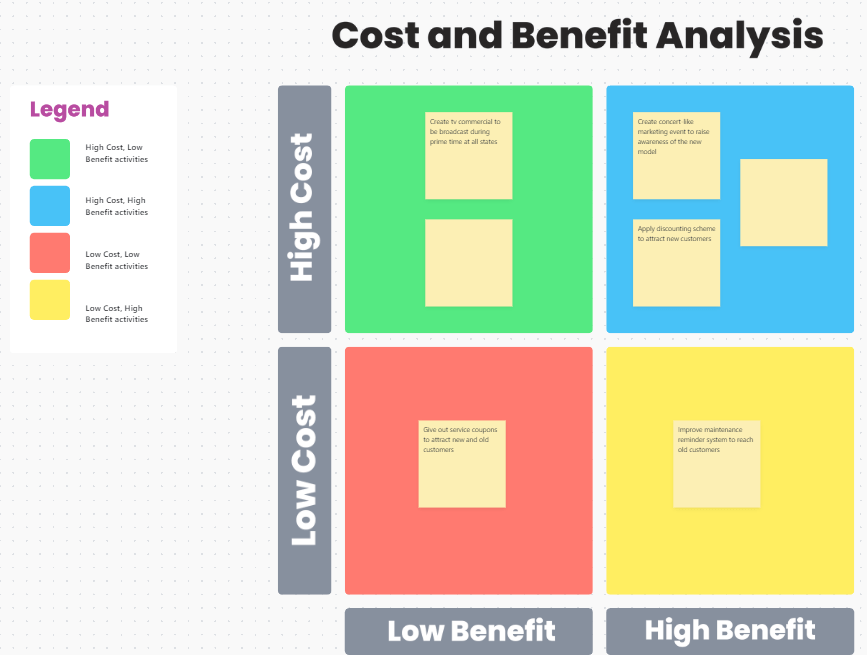
قم بإجراء تحليل مرئي للتكاليف والمنافع لمشروعك لتحديد الأنشطة والوظائف المولدة لعائد الاستثمار في عملك
/ctaBtn/الأخضر https://app.clickup.com/signup?template=t-200519120 قم بتنزيل هذا النموذج /%ctaBtntn/
وبالمثل، فإن نموذج تحليل نقاط القوة والضعف والفرص والأخطار يمكن أن يغنيك عن تدوين صفوف من البيانات لتحديد نقاط القوة والضعف والفرص والتهديدات في مبادرتك. إنه نموذج غني بصرياً يتيح لك تحديد الأنشطة والوظائف عالية التأثير بسهولة.

قم بإجراء تحليل SWOT قابل للتنفيذ باستخدام نموذج تحليل SWOT من ClickUp لاتخاذ قرارات مستنيرة
/ctaBtn/الأخضر https://app.clickup.com/signup?template=t-32j5zud تنزيل هذا القالب /%ctaBtntn/
الخطوة 5: تقييم البدائل
في هذا القسم، يجب عليك تقييم البدائل للحل المقترح في دراسة الجدوى. قم بتسليط الضوء على إيجابيات وسلبيات كل خيار حتى يتمكن أصحاب المصلحة من الحصول على نظرة عامة كاملة عن كل حل ممكن. احرص على إدراج الحل الذي اقترحته في المقارنة أيضًا لشرح سبب كونه أفضل من جميع البدائل.
إذا كنت بحاجة إلى المساعدة في فحص البدائل ومقارنتها، فارجع إلى نموذج مصفوفة مقارنة ClickUp . استخدمه لتسجيل جميع المعلومات حول كل بديل محتمل في حقول مختلفة ثم قارن بينها على لوحة كانبان. يجعل تنسيقها المرئي عملية اتخاذ القرار أسهل، بينما تسمح لك حقولها القابلة للتخصيص بالكامل بتسجيل أي عدد تريده من معاملات المقارنة.
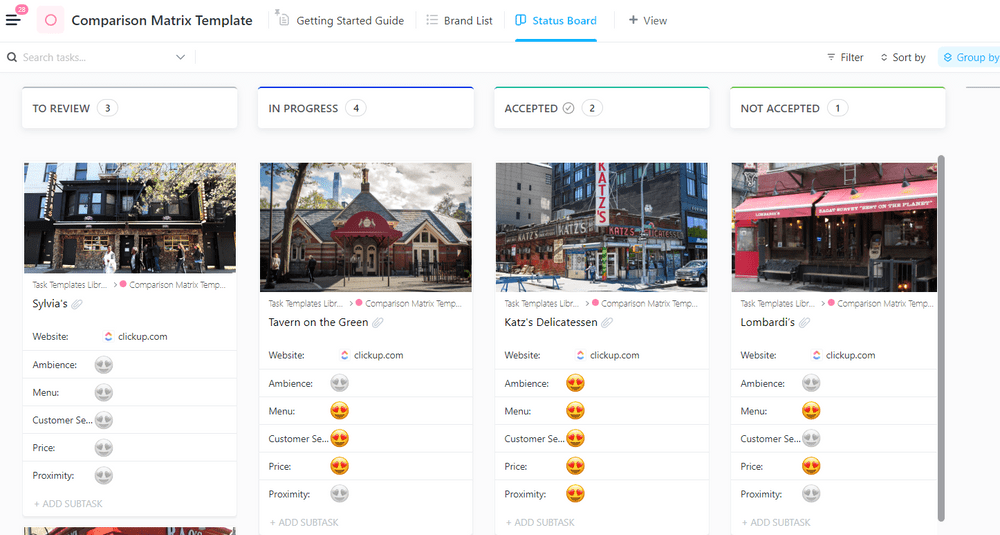
استخدم قالب مصفوفة المقارنة وطريقة عرض اللوحة والقائمة في ClickUp لتحليل ومقارنة أبرز البدائل لمبادرتك
/ctaBtn/الأخضر https://app.clickup.com/signup?template=t-200540429 تنزيل هذا القالب /%ctaBtntn/
الخطوة 6: وصف نطاق المشروع ونهج التنفيذ
بعد أن تقوم بتفصيل جميع الجوانب المالية لمشروعك ومقارنته بالبدائل، قم بتحديد نطاق المشروع في حالة عملك. يحدد هذا القسم حدود العمل المعلق والقيود المفروضة على الموارد اللازمة لإكماله. وتشمل المعلومات الحاسمة التي يغطيها ما يلي:
- الميزانية وتخصيص الموارد: الموارد المالية وغيرها من الموارد، مثل أعضاء الفريق ومساحة العمل والمعدات وما إلى ذلك، التي ينبغي تخصيصها للمشروع
- المواعيد النهائية: الوقت اللازم لإكمال كل جزء من المشروع
- التبعيات والعلاقات : تفاصيل وظائف العمل الحالية التي قد تتأثر بالمشروع
- المنجزات: ما تخطط لتسليمه بنهاية مشروعك
- الاستثناءات: ما ليس جزءًا من مشروعك
بمجرد تحديد نطاق المشروع، حدد الخطوات الدقيقة لتنفيذه. أسهل طريقة لفعل ذلك هي استخدام نموذج نطاق عمل ClickUp . يسمح لك بتسجيل كل جانب من جوانب نطاق المشروع بطريقة منظمة بشكل جيد لمشاركته مع أصحاب المصلحة والحصول على آرائهم.
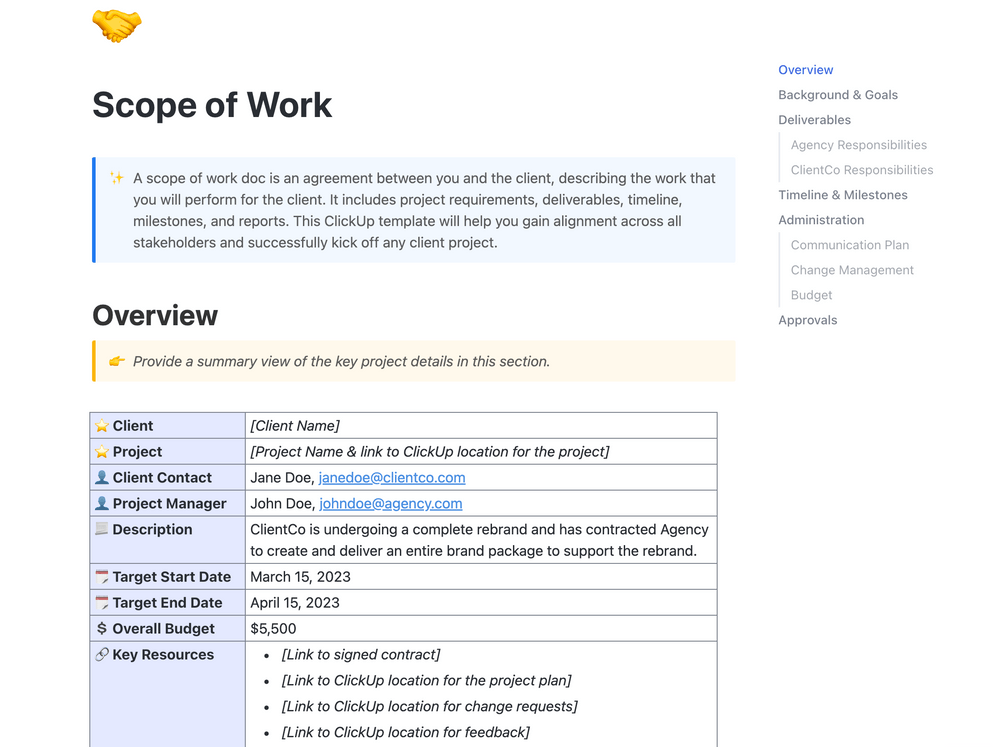
يمكن أن يساعدك قالب ClickUp نطاق العمل في تحديد جميع تفاصيل المشروع
/ctaBtn/الأخضر https://app.clickup.com/signup?template=kkmvq-3306144 تنزيل هذا القالب /%ctaBtntn/
الخطوة 7: ### الخطوة 7: صياغة الملخص التنفيذي
بمجرد الانتهاء من جميع الأقسام الرئيسية لحالة العمل الخاصة بك، تحتاج إلى صياغة ملخص تنفيذي لاستيعاب التفاصيل المهمة من كل قسم. يجب أن يكون هذا الملخص موجزًا، ومن الأفضل ألا يزيد عن صفحتين. سيظهر كالبند الأول في دراسة الجدوى الخاصة بك، مما يوفر لأصحاب المصلحة نظرة عامة سريعة على مشروعك المقترح.
إذا كنت بحاجة إلى مساعدة في صياغة الملخص التنفيذي الخاص بك، فيمكنك التعاون مع ClickUp Brain وهو عبارة عن شبكة عصبية ومساعد للكتابة بالذكاء الاصطناعي مدمج في ClickUp Docs. في ثوانٍ معدودة، يمكنه إنشاء ملخص مثالي لأي مستند حالة عمل تم إعداده حتى الآن.

استفد من ClickUp AI لتلخيص اجتماعاتك وإنشاء عناصر العمل
بمجرد الحصول على مسودة الملخص التنفيذي الخاص بك، استخدم قالب الملخص التنفيذي ل ClickUp لتنسيقه وتنظيمه بطريقة منظمة وقابلة للعرض.

أنشئ ملخصًا مقنعًا لحالة عملك باستخدام قالب الملخص التنفيذي من ClickUp
/ctaBtn/الأخضر https://app.clickup.com/signup?template=kkmvq-6094488 تنزيل هذا القالب /%ctaBtntn/
الخطوة 8: وضع كل شيء معًا
والآن، حان الوقت لتجميع وهيكلة جميع الأقسام التي تمت صياغتها حتى هذه النقطة لوضع اللمسات الأخيرة على حالة عملك. وهنا يأتي دور قالب تحليل حالة العمل ClickUp يمكن أن يكون منقذًا.
يتضمن القالب أقسامًا مخصصة لتسجيل كل جزء من حالة العمل. يتم ترتيب جميع الأقسام بطريقة منظمة لضمان أنه عندما تعرض قضيتك يكون لها تأثير دائم على أصحاب المصلحة.

تم تصميم قالب تحليل حالة الأعمال من ClickUp لمساعدتك في تحليل التأثير المحتمل لقرار ما على عملك.
/ctaBtn/الأخضر https://app.clickup.com/signup?template=kkmvq-6061788 تنزيل هذا القالب /%ctaBtntn/
أمثلة واقعية لحالات الأعمال التجارية
الآن بعد أن تعرفت على كيفية كتابة حالة عمل، دعنا نلقي نظرة على بعض الأمثلة الواقعية لكيفية سماح حالات العمل للشركات بالموافقة على المشاريع الكبرى واتخاذ القرارات الاستراتيجية:
مثال على الشركات الناشئة المرنة
تواجه شركة ناشئة مرنة تعمل في مجال الرعاية الصحية مشاكل في القوى العاملة، مما يمنعها من إطلاق منتجها في الوقت المحدد. ويرغب رئيس فريق تطوير المنتج في توظيف ثلاثة مهندسين إضافيين لتسريع عملية إطلاق المنتج في الوقت المحدد عملية تطوير المنتج .
ومع ذلك، نظرًا لأنها شركة ناشئة بسيطة مع قيود الميزانية يحتاج رئيس الفريق إلى موافقة مؤسسي الشركة الناشئة قبل اتخاذ القرار. لذا، يقوم فريق المنتج بتجميع حالة عمل لتعيين موظفين إضافيين، وفيما يلي العناصر الرئيسية لاقتراحهم:
- لمحة موجزة عن كيف أن عدم كفاية الموظفين يؤخر تطوير المنتج ويدفع إطلاق المنتج إلى ما بعد الموعد النهائي المخطط له
- توضيح كيف يمكن لثلاثة مهندسين جدد أن يجلبواتطوير المنتج العودة إلى المسار الصحيح
- تحليل تكلفة وفوائد هذه الخطوة
- استكشاف المخاطر المرتبطة بها
- عرض البدائل والمخاطر المرتبطة بها
- نطاق التغيير، مثل طبيعة العمل الذي سيؤديه المهندسون الجدد
مثال على تمويل رأس المال الاستثماري
قررت شركة ناشئة في مجال التكنولوجيا المالية ممولة برأس مال استثماري إطلاق خط إنتاج جديد من بطاقات الائتمان. سيسمح ذلك للشركة الناشئة بضم عدد كبير من العملاء الجدد، ولكنه سيتطلب أيضًا قدرًا كبيرًا من التمويل الاستثمار في التسويق وأغراض الإقراض. لذا تقوم الشركة بإعداد دراسة جدوى لخط الإنتاج الجديد هذا في محاولة للحصول على تمويل له. وإليك ما توضحه الشركة بالتفصيل في دراسة الجدوى:
- الحاجة إلى خط الإنتاج الجديد هذا وكيف أنه يكمل عروض الشركة الأخرى
- فرصة السوق مع توقعات الإيرادات وتحليل التكاليف والفوائد
- المخاطر التي ينطوي عليها المشروع، مثل المنافسة والتقصير الجماعي والتدقيق التنظيمي
- البدائل المتاحة، مثل إطلاق بطاقات السحب الآلي مسبقة الدفع، والتي ربما لن تكون مفيدة فياكتساب العملاء
- نطاق المشروع، مثل أعضاء الفريق الذي يعمل على المشروع، والميزانية المخصصة، والجدول الزمني للإطلاق، والجدول الزمني
مثال على الاستعانة بمصادر خارجية
A برنامج SaaS بائع مقره خارج وادي السيليكون يريد تقليل الإنفاق على خدمة العملاء دون المساس بخدمة العملاء جودة الخدمة . إن مدير المنتج لأحد منتجاتهم الرائدة بفكرة الاستعانة بمصادر خارجية لخدمة العملاء. لذا، قرروا إعداد دراسة جدوى قبل اقتراح الحل على الإدارة. توضح دراسة الجدوى:
- المشكلة التي تتمثل في أن حصة كبيرة من الإيرادات تذهب إلى عمليات خدمة العملاء وكيف يمكن للاستعانة بمصادر خارجية أن تساعد في خفضها
- المخاطر المرتبطة بالاستعانة بمصادر خارجية لخدمة العملاء واستراتيجيات التخفيف من حدتها، مثل وجود آلية تصعيد لتذاكر الدعم التي لم يتم حلها
- البدائل ومخاطرها، مثل استخدامروبوتات الدردشة الآلية القائمة على الذكاء الاصطناعي لأتمتة خدمة العملاءوالتي يمكن أن تكون محبطة للعملاء الذين يحتاجون إلى إرشادات بشرية
- تحليل التكلفة والعائد من إجراء التغيير
- نطاق التغيير، مثل عدد موظفي دعم العملاء الذين سيتم الاستغناء عنهم
مثال على سلسلة التوريد
تواجه شركة إنشاءات في فيرجينيا مشاكل في توريد المواد الخام. يفشل مورد الأسمنت الذي يعملون معه بشكل متكرر في تلبية الطلب، لذلك يقرر المشرف على المشروع إضافة بعض التكرار من خلال تعيين مورد جديد.
يمكن أن يؤثر هذا التغيير بشكل كبير على المشروع، لذلك يقوم المشرف بإعداد دراسة حالة عمل لاقتراح المبادرة على الإدارة. تتناول الحالة ما يلي:
- كيف يمكن لمورد الأسمنت الجديد أن يحافظ على المشروع من التأخير
- موثوقية المورد، كما يتضح من سنوات تواجده في الصناعة، والشركات الكبرى التي قام بتوريد الأسمنت لها، إلخ.
- معلومات عن الموردين البدلاء وقدراتهم وموثوقيتاتهم
- تحليل تكلفة وفائدة إجراء التغيير، حيث أن أسعار هذا المورد أعلى قليلاً من أسعار المورد الحالي
- نطاق التغيير، بما في ذلك مقدار الإمدادات التي سيتم توريدها من قبل المورد الجديد، ومدة التوريد، والسعر
تحديات حالة العمل المحتملة وكيفية التغلب عليها
هناك عدد من الأخطاء التي يرتكبها مديرو المشاريع عند صياغة دراسة الجدوى، والتي يمكن أن تعرض الموافقة على المشروع أو المبادرة بأكملها للخطر. والآن بعد أن قمنا بتغطية العملية الكاملة لكتابة حالة عمل مقنعة، دعونا نلقي نظرة على أكثر المزالق شيوعًا ونستكشف طرق تجنبها.
1. صياغتها بمفردك
تتطلب تفاصيل دراسة حالة العمل بحثًا مكثفًا ومعرفة واسعة بوظائف العمل المختلفة. لا يوجد مدير المشروع يمكنه القيام بكل ذلك بمفرده دون ارتكاب أخطاء أو أخطاء في التقدير، لذلك ابحث عن المساعدة من مختلف الأقسام في شركتك، سواء كانت المالية أو التسويق أو العمليات. 💁
2. عدم أخذ آراء أصحاب المصلحة
من الأخطاء الحاسمة الأخرى عند بناء دراسة الجدوى تقديم المستند إلى أصحاب المصلحة بشكل مفاجئ. عندما لا تشرك أصحاب المصلحة المعنيين في أي مرحلة من مراحل عملية تطوير دراسة الجدوى، فإنك تزيد من خطر رفضها. ويحدث ذلك بسبب:
- أنت لا تقوم بما يليمعرفة توقعاتهم
- لم يكن لديهم أي دور في قضية عملك، مما يجعلهم منفصلين عن عملك
لتجنب هذا السيناريو، قم بإشراك أصحاب المصلحة في مراحل مختلفة من عملية صياغة حالة عملك واحصل على مراجعة التقدم المحرز بانتظام.
3. عدم المراجعة أو التدقيق اللغوي
آخر شيء تريده عند عرض حالة عملك هو خطأ مطبعي أو تحريف للحقائق. فقد يترك ذلك انطباعًا سيئًا لدى أصحاب المصلحة الذين يستمعون إلى عرضك. وقد لا يأخذونك على محمل الجد ويرفضونك في النهاية مقترح مشروعك .
ولضمان الحصول على مستند محكم، يجب عليك دائماً المراجعة والتدقيق اللغوي حالة عملك بالكامل قبل تقديمها. انتبه بشكل خاص للأرقام والحقائق وتحقق مرة أخرى من صحتها. ثم تابع عرضك.
قم بإنشاء حالة عمل مقنعة باستخدام ClickUp
تعتبر دراسة الجدوى القوية هي الخطوة الأولى للحصول على موافقة أصحاب المصلحة على المشروع. ومع ذلك، فإن بناءها يتطلب تخطيطًا دقيقًا وأدوات مناسبة لتبسيط العملية بأكملها. ولحسن الحظ، تزوّدك ClickUp بكل ما تحتاجه في كل خطوة من خطوات بناء دراسة الجدوى - بدءًا من القوالب الجاهزة وأدوات التوثيق إلى المساعدة في الكتابة المدعومة بالذكاء الاصطناعي. اشترك في ClickUp اليوم واكتب دراسة جدوى من شأنها كسب الدعم والثقة لمشروعك أو مبادرتك.
